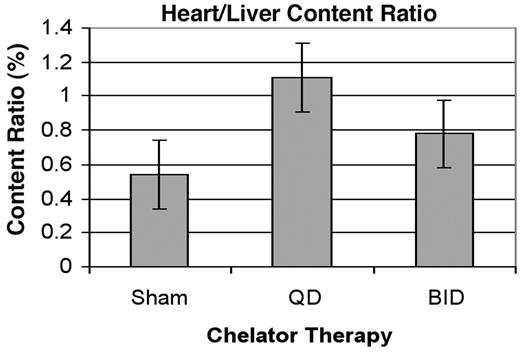Abstract
Introduction: Iron cardiomyopathy remains the leading cause of death in thalassemia major patients because effective chelation of cardiac iron is difficult. Cardiac iron stores respond more slowly to chelation therapy and appear to require a sustained gradient of labile iron species between myocytes and serum. We have previously demonstrated the efficacy of once-daily deferasirox in removing stored cardiac iron in the gerbil but changes in cardiac iron were relatively modest compared with hepatic iron. We postulated that twice daily dosing (BID), by sustaining a longer labile iron gradient from myocytes to serum, would produce better cardiac iron chelation than a comparable once daily dose (QD).
Methods: Twenty four eight-to-ten week old female Mongolian gerbils underwent iron dextran loading for 10 weeks, followed by a 1 week iron equilibration period. Animals were divided into 3 treatment groups of 8 animals apiece and treated with deferasirox 100 mg/kg/day as a single dose (n=8), deferasirox 100 mg/kg/day divided BID (n=8), or sham chelation (n=8) for a total of 12 weeks. Following euthanasia, organs were harvested for quantitative iron determination and tissue histology.
Results: All of the animals tolerated the 10-week loading and 12-week chelation with no adverse events. After the 22-week period, hepatic iron content was 17.7 ± 4.8 mg and 21.1 ± 5.3 mg in the QD and BID groups, compared with 43.1 ± 5.3 mg in the sham-chelated animals (p < 0.0001 sham versus treatment, p=0.2 between groups). Corresponding cardiac iron content was 0.19 ± 0.04 mg, 0.16 ± 0.04 mg and 0.23 ± 0.04 mg respectively. These changes were significant in the BID group (p< 0.006 versus sham). While BID versus QD cardiac iron contents were not statistically different, treatment groups were clearly distinct when viewed as a scattergram of heart and liver iron content (Figure 1). The BID treated animals exhibited lower cardiac iron for any given hepatic iron content. This is best observed by comparing the ratio of cardiac to hepatic iron content (Figure 2, which was 0.78% in the BID group versus 1.11% in the QD treated animals (p=0.0007).
Discussion: In Mongolian gerbils, deferasirox effectively removed liver and cardiac iron with either BID or QD dosing. BID dosing changed the relative cardiac and liver iron chelation profile compared with QD dosing, trading improvements in cardiac iron elimination for a modest decrease in hepatic chelation. Caution should be exercised in extrapolating these results to humans, however clinical studies of BID administration should be considered for patients requiring high chelator dosing or who have high cardiac iron burden.
Disclosures: Dr. Nick is an employee of Novartis Pharma.; Dr. Wood is a consultant for Novartis Pharma and Apotex.; Dr. Wood has received research funding from Novartis Pharma and Apotex.; Dr Wood has received honoraria from Novartis Pharma and Apotex.; Dr. Wood contributed to the Exjade Speakers Bureau curriculum.
Author notes
Corresponding author



This feature is available to Subscribers Only
Sign In or Create an Account Close Modal